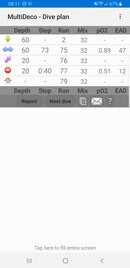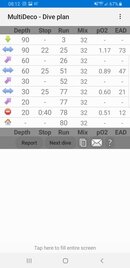You are using an out of date browser. It may not display this or other websites correctly.
You should upgrade or use an alternative browser.
You should upgrade or use an alternative browser.
GUE (and other non-PADI) Open Water Standards for No-Deco Limits
- Thread starter diver42
- Start date
Please register or login
Welcome to ScubaBoard, the world's largest scuba diving community. Registration is not required to read the forums, but we encourage you to join. Joining has its benefits and enables you to participate in the discussions.
Benefits of registering include
- Ability to post and comment on topics and discussions.
- A Free photo gallery to share your dive photos with the world.
- You can make this box go away
Finnish Divers Federation still sells their own RGBM NDL tables, which they apparently licensed from Wienke. NAUI has also published RGBM NDL tables in the past. I don't know the exact history, but our federation used to have collaboration with NAUI. Also Suunto being a local company and very popular dive computer may have something to do with popularity of RGBM.
helodriver87
Contributor
I planned two NDL dives both on Nx32, GF = 20/80 and I looked at the remaining NDL and I don't see where they are close at all.
Dive 1: 90 ft/25 min, 60 ft/25 min, 30 ft/25 min. NDL remaining after 25 min at 60 ft = 24 min.
Dive 2: 60 ft/75 min. NDL remaining after 75 min at 60 ft = 7 min. (60 ft is the average depth of dive 1).
if the average of the total dive time (25 min) is used for dive 2 the remaining NDL = 57 min.
Please explain how using the average depth makes the dives close?
Looks identical to me.
Attachments
- Messages
- 17,334
- Reaction score
- 13,743
- # of dives
- 100 - 199
The Norwegian Diving Association use our national standard diving tables, which cover not only NDL diving, but also staged decompression dives. They're based on the RN Table 11, which again is based on a (non-Haldanean) dissolved gas model, but have been tweaked based on data from the rather extensive professional diving taking place in our waters. And it's THE table for commercial diving in our waters. What's interesting is that they use a much slower "slowest tissue" compartment than e.g. the PADI RDP does, so it's much more in accordance with the USN table or the BSAC-88 table when it comes to repetitive dives. Or, IOW, a lot more conservative for the second dive of the day than what the PADI RDP is.Finnish Divers Federation still sells their own RGBM NDL tables, which they apparently licensed from Wienke. NAUI has also published RGBM NDL tables in the past. I don't know the exact history, but our federation used to have collaboration with NAUI. Also Suunto being a local company and very popular dive computer may have something to do with popularity of RGBM.
Funny you should mention Suunto, though. I had the pleasure of listening to a presentation by the main author of our diving tables, and being a Suunto user, I asked him about the Suunto RGBM model. According to him, it's basically a dissolved gas model with some minor RGBM tweaks added on and collapses to a dissolved gas model for simple NDL dives. Although it will punish you for too fast ascents, skipped safety stops and sawtooth profiles. And speaking from experience, it'll get a little grumpy if I follow our tables' standard ascent rate of 10 m/min. For square profile dives, it follows the PADI RDP pretty closely (plusminus one to two minutes of NDL time)
According to him, it's basically a dissolved gas model with some minor RGBM tweaks on top and collapses to a dissolved gas model for simple NDL dives. Although it will punish you for too fast ascents, skipped safety stops and sawtooth profiles. And speaking from experience, it'll get a little grumpy if I follow our tables' standard ascent rate of 10 m/min.
This is getting seriously off-topic but indeed, it hasn't been a real RGMB algorithm but a mimic. Originally this was probably due to limited computing power of wrist mounted devices. Now with their latest Suunto Fused RGBM 2 they actually claim they are using "real" RGBM for deep/long dives as part of that fused system.
Not a Suunto diver myself, and never actually used the RGBM tables either.
MultiDeco does not show time-remaining before hitting NDL (or MDL, or whatever).Looks identical to me.
helodriver87
Contributor
MultiDeco does not show time-remaining before hitting NDL (or MDL, or whatever).
I get that. They aren't actually identical, but from a recreational dive planning perspective, you can treat them that way for simplicity.
What software are you using? I want to recreate what you’re seeing.
I used my own spreadsheet but I discovered that the Buhlmann C table a coefficients were bad. I corrected it and now I get 2 and 5 minutes for NDL at 60 ft. I tried using MultiDeco but it inserts stops at 10 ft and doesn't show NDL remaining. Even a dive to 60 ft for 10 minutes it inserts a stop at 10 ft?!!! I'll have to read the help. Anyway, yeah, it's kinda neat how that works out.
BTW, I'll be posting yet another revision of my ss (sigh) soon in the Advanced forum.
A big part of the reason is the 20/85.From the GUE table (posted in this thread earlier): Min deco time for 100fsw/30msw dive is 30 minutes. This puts you under a ceiling after 20 minutes (based on 20/85).
You won't violate that ceiling with a GUE min deco ascent.
But it is a ceiling if someone defines NDL as "direct ascent" without any stops (at what speed?). Someone could hit this ceiling with CESA for example (not taught by GUE I think).
@Bob DBF is this what you meant?
View attachment 527196
Pretty much every recreational table made is 1) not using GFs 2) if you had to force GFs onto a no stop recreational dive it would be more like 100/100 by definition.
Similar threads
- Replies
- 105
- Views
- 8,666
- Replies
- 2
- Views
- 290
- Replies
- 37
- Views
- 3,997
- Replies
- 13
- Views
- 980






